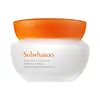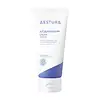What's inside
What's inside
 Key Ingredients
Key Ingredients

 Benefits
Benefits

 Concerns
Concerns

 Ingredients Side-by-side
Ingredients Side-by-side

Water
Skin ConditioningButylene Glycol
HumectantGlycerin
HumectantButylene Glycol Dicaprylate/Dicaprate
EmollientCetyl Ethylhexanoate
EmollientCaprylic/Capric Triglyceride
MaskingCyclopentasiloxane
EmollientDiisostearyl Malate
Emollient1,2-Hexanediol
Skin ConditioningGlyceryl Stearate
EmollientPolyglyceryl-3 Methylglucose Distearate
EmulsifyingCyclohexasiloxane
EmollientPEG-100 Stearate
Cetearyl Alcohol
EmollientHydroxyethyl Acrylate/Sodium Acryloyldimethyl Taurate Copolymer
Emulsion StabilisingPolyacrylate-13
Polymethylsilsesquioxane
Polyisobutene
Parfum
MaskingHoney
HumectantZiziphus Jujuba Fruit Extract
Skin ConditioningGlyceryl Caprylate
EmollientLimonene
PerfumingLycium Chinense Fruit Extract
AntioxidantSorbitan Isostearate
EmulsifyingPropanediol
SolventEthylhexylglycerin
Skin ConditioningDisodium EDTA
Adenosine
Skin ConditioningPolysorbate 20
EmulsifyingPueraria Lobata Root Extract
HumectantPolysorbate 60
EmulsifyingDioscorea Japonica Root Extract
Skin ConditioningCrataegus Pinnatifida Fruit Extract
Skin ConditioningLinalool
PerfumingNarcissus Tazetta Bulb Extract
AstringentPueraria Thunbergiana Flower/Leaf/Stem Extract
Skin ConditioningCitronellol
PerfumingDextrin
AbsorbentTheobroma Cacao Extract
Skin ConditioningMorus Alba Leaf Extract
Skin ConditioningCitral
PerfumingGeraniol
PerfumingRehmannia Glutinosa Root Extract
Skin ConditioningGlycyrrhiza Uralensis Root Extract
Skin ConditioningPaeonia Lactiflora Root Extract
Skin ConditioningLilium Candidum Bulb Extract
Skin ConditioningPolygonatum Odoratum Rhizome Extract
Skin ConditioningBenzyl Benzoate
AntimicrobialNelumbo Nucifera Flower Extract
Skin ConditioningHydrolyzed Soybean Extract
Skin ConditioningTocopherol
AntioxidantWater, Butylene Glycol, Glycerin, Butylene Glycol Dicaprylate/Dicaprate, Cetyl Ethylhexanoate, Caprylic/Capric Triglyceride, Cyclopentasiloxane, Diisostearyl Malate, 1,2-Hexanediol, Glyceryl Stearate, Polyglyceryl-3 Methylglucose Distearate, Cyclohexasiloxane, PEG-100 Stearate, Cetearyl Alcohol, Hydroxyethyl Acrylate/Sodium Acryloyldimethyl Taurate Copolymer, Polyacrylate-13, Polymethylsilsesquioxane, Polyisobutene, Parfum, Honey, Ziziphus Jujuba Fruit Extract, Glyceryl Caprylate, Limonene, Lycium Chinense Fruit Extract, Sorbitan Isostearate, Propanediol, Ethylhexylglycerin, Disodium EDTA, Adenosine, Polysorbate 20, Pueraria Lobata Root Extract, Polysorbate 60, Dioscorea Japonica Root Extract, Crataegus Pinnatifida Fruit Extract, Linalool, Narcissus Tazetta Bulb Extract, Pueraria Thunbergiana Flower/Leaf/Stem Extract, Citronellol, Dextrin, Theobroma Cacao Extract, Morus Alba Leaf Extract, Citral, Geraniol, Rehmannia Glutinosa Root Extract, Glycyrrhiza Uralensis Root Extract, Paeonia Lactiflora Root Extract, Lilium Candidum Bulb Extract, Polygonatum Odoratum Rhizome Extract, Benzyl Benzoate, Nelumbo Nucifera Flower Extract, Hydrolyzed Soybean Extract, Tocopherol
Water
Skin ConditioningButylene Glycol
HumectantGlycerin
HumectantButylene Glycol Dicaprylate/Dicaprate
EmollientCetyl Ethylhexanoate
EmollientSqualane
EmollientPentaerythrityl Tetraisostearate
EmollientDicaprylyl Carbonate
EmollientBehenyl Alcohol
EmollientDimethicone
EmollientHydroxypropyl Bispalmitamide Mea
EmollientStearic Acid
CleansingBetaine
HumectantMannitol
HumectantC14-22 Alcohols
Emulsion StabilisingPalmitic Acid
EmollientHydroxypropyl Bislauramide Mea
EmollientArachidyl Alcohol
EmollientCholesterol
EmollientPolyacrylate-13
C12-20 Alkyl Glucoside
EmulsifyingAllantoin
Skin ConditioningArachidyl Glucoside
EmulsifyingNiacinamide
SmoothingCeramide NP
Skin ConditioningGlyceryl Caprylate
EmollientEthylhexylglycerin
Skin ConditioningHydrogenated Polyisobutene
EmollientCarbomer
Emulsion StabilisingTromethamine
BufferingDimethiconol
EmollientPolyglyceryl-10 Laurate
Skin ConditioningHydrogenated Lecithin
EmulsifyingEthylhexyl Palmitate
EmollientAcrylates/Ammonium Methacrylate Copolymer
Sorbitan Isostearate
EmulsifyingSilica
AbrasivePhytosphingosine
Skin ConditioningSphingolipids
EmollientArachidic Acid
CleansingTocopherol
AntioxidantOleic Acid
EmollientWater, Butylene Glycol, Glycerin, Butylene Glycol Dicaprylate/Dicaprate, Cetyl Ethylhexanoate, Squalane, Pentaerythrityl Tetraisostearate, Dicaprylyl Carbonate, Behenyl Alcohol, Dimethicone, Hydroxypropyl Bispalmitamide Mea, Stearic Acid, Betaine, Mannitol, C14-22 Alcohols, Palmitic Acid, Hydroxypropyl Bislauramide Mea, Arachidyl Alcohol, Cholesterol, Polyacrylate-13, C12-20 Alkyl Glucoside, Allantoin, Arachidyl Glucoside, Niacinamide, Ceramide NP, Glyceryl Caprylate, Ethylhexylglycerin, Hydrogenated Polyisobutene, Carbomer, Tromethamine, Dimethiconol, Polyglyceryl-10 Laurate, Hydrogenated Lecithin, Ethylhexyl Palmitate, Acrylates/Ammonium Methacrylate Copolymer, Sorbitan Isostearate, Silica, Phytosphingosine, Sphingolipids, Arachidic Acid, Tocopherol, Oleic Acid
 Reviews
Reviews

Ingredients Explained
These ingredients are found in both products.
Ingredients higher up in an ingredient list are typically present in a larger amount.
Butylene Glycol (or BG) is used within cosmetic products for a few different reasons:
Overall, Butylene Glycol is a safe and well-rounded ingredient that works well with other ingredients.
Though this ingredient works well with most skin types, some people with sensitive skin may experience a reaction such as allergic rashes, closed comedones, or itchiness.
Learn more about Butylene GlycolWe don't have a description for Butylene Glycol Dicaprylate/Dicaprate yet.
Cetyl Ethylhexanoate is an emollient ester. It comes from cetearyl alcohol and 2-ethylhexanoic acid.
Cetyl Ethylhexanoate is an emollient that adds a velvety feel to skin without being greasy or oily. Emollients help trap moisture into your skin, keeping your skin soft and hydrated.
Ethylhexylglycerin (we can't pronounce this either) is commonly used as a preservative and skin softener. It is derived from glyceryl.
You might see Ethylhexylglycerin often paired with other preservatives such as phenoxyethanol. Ethylhexylglycerin has been found to increase the effectiveness of these other preservatives.
Glycerin is already naturally found in your skin. It helps moisturize and protect your skin.
A study from 2016 found glycerin to be more effective as a humectant than AHAs and hyaluronic acid.
As a humectant, it helps the skin stay hydrated by pulling moisture to your skin. The low molecular weight of glycerin allows it to pull moisture into the deeper layers of your skin.
Hydrated skin improves your skin barrier; Your skin barrier helps protect against irritants and bacteria.
Glycerin has also been found to have antimicrobial and antiviral properties. Due to these properties, glycerin is often used in wound and burn treatments.
In cosmetics, glycerin is usually derived from plants such as soybean or palm. However, it can also be sourced from animals, such as tallow or animal fat.
This ingredient is organic, colorless, odorless, and non-toxic.
Glycerin is the name for this ingredient in American English. British English uses Glycerol/Glycerine.
Learn more about GlycerinGlyceryl Caprylate comes from glycerin and caprylic acid, a fatty acid from coconut. It has emollient and emulsifier properties.
As an emollient, it helps hydrate your skin. Emollients work by creating a barrier on your skin to trap moisture in, helping to keep your skin soft and smooth.
On the other hand, emulsifiers prevent ingredients (such as oil and water) from separating.
Learn more about Glyceryl CaprylatePolyacrylate-13 is a type of acrylate polymer. Acrylate polymers are commonly used as adhesives in cosmetics.
Polyacrylate-13 creates a film to protect the skin. It is also used to thicken and stabilize a product. It works by making water a gel-like consistency. This gel consistency helps suspend particles.
Polyacrylate-13 is a copolymer of acrylic acid, acrylamide, sodium acrylate, sodium acryloyldimethyltaurate monomers
Learn more about Polyacrylate-13Sorbitan Isostearate is an emulsifer and cleaning agent. It is created from isostearic acid and sorbitol.
As an emulsifier, Sorbitan Isostearate prevents oils and water from separating.
Due to its isostearic acid base, it may not be safe for Malassezia or fungal acne.
Learn more about Sorbitan IsostearateTocopherol (also known as Vitamin E) is a common antioxidant used to help protect the skin from free-radicals and strengthen the skin barrier. It's also fat soluble - this means our skin is great at absorbing it.
Vitamin E also helps keep your natural skin lipids healthy. Your lipid skin barrier naturally consists of lipids, ceramides, and fatty acids. Vitamin E offers extra protection for your skin’s lipid barrier, keeping your skin healthy and nourished.
Another benefit is a bit of UV protection. Vitamin E helps reduce the damage caused by UVB rays. (It should not replace your sunscreen). Combining it with Vitamin C can decrease sunburned cells and hyperpigmentation after UV exposure.
You might have noticed Vitamin E + C often paired together. This is because it is great at stabilizing Vitamin C. Using the two together helps increase the effectiveness of both ingredients.
There are often claims that Vitamin E can reduce/prevent scarring, but these claims haven't been confirmed by scientific research.
Learn more about TocopherolWater. It's the most common cosmetic ingredient of all. You'll usually see it at the top of ingredient lists, meaning that it makes up the largest part of the product.
So why is it so popular? Water most often acts as a solvent - this means that it helps dissolve other ingredients into the formulation.
You'll also recognize water as that liquid we all need to stay alive. If you see this, drink a glass of water. Stay hydrated!
Learn more about Water